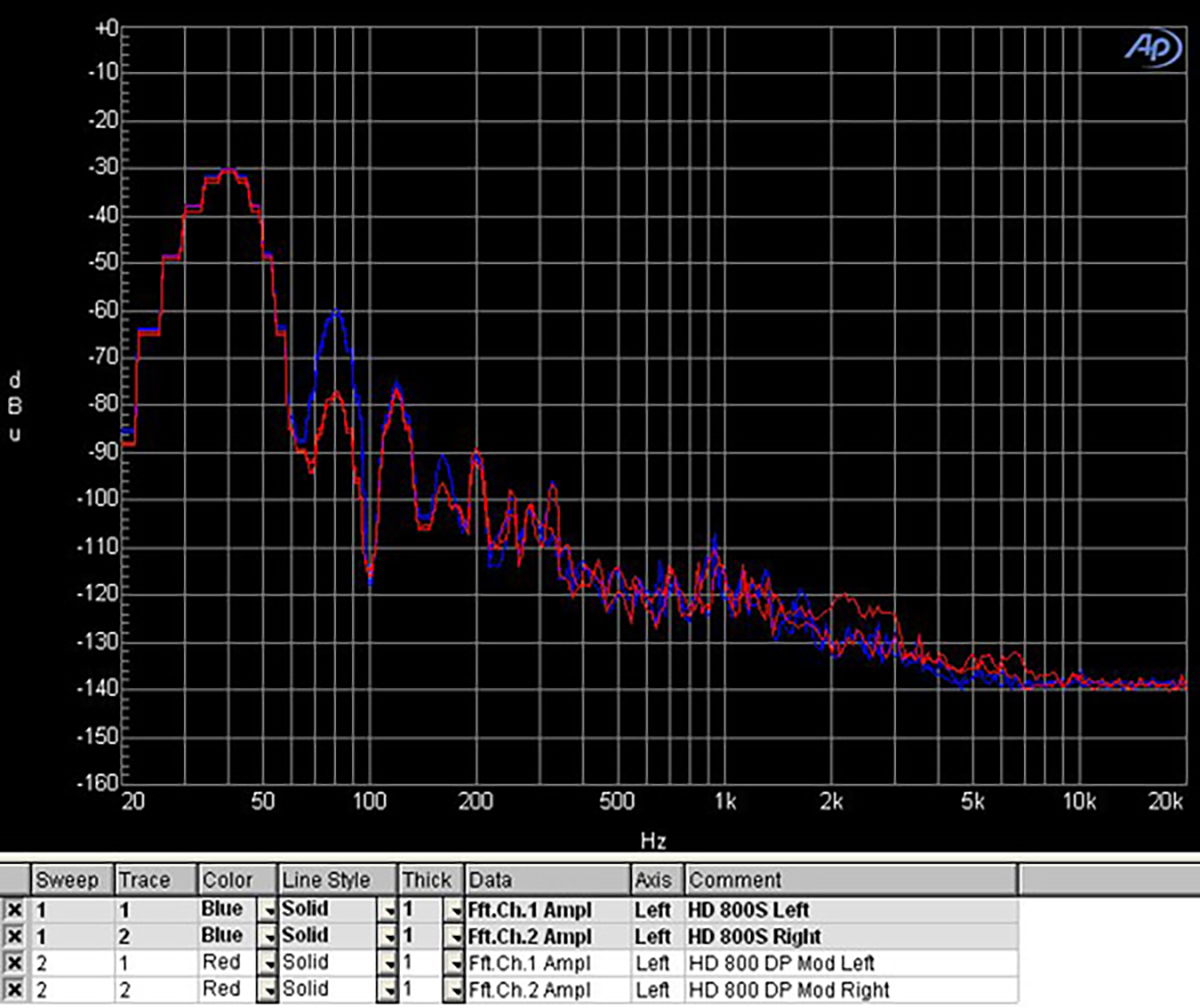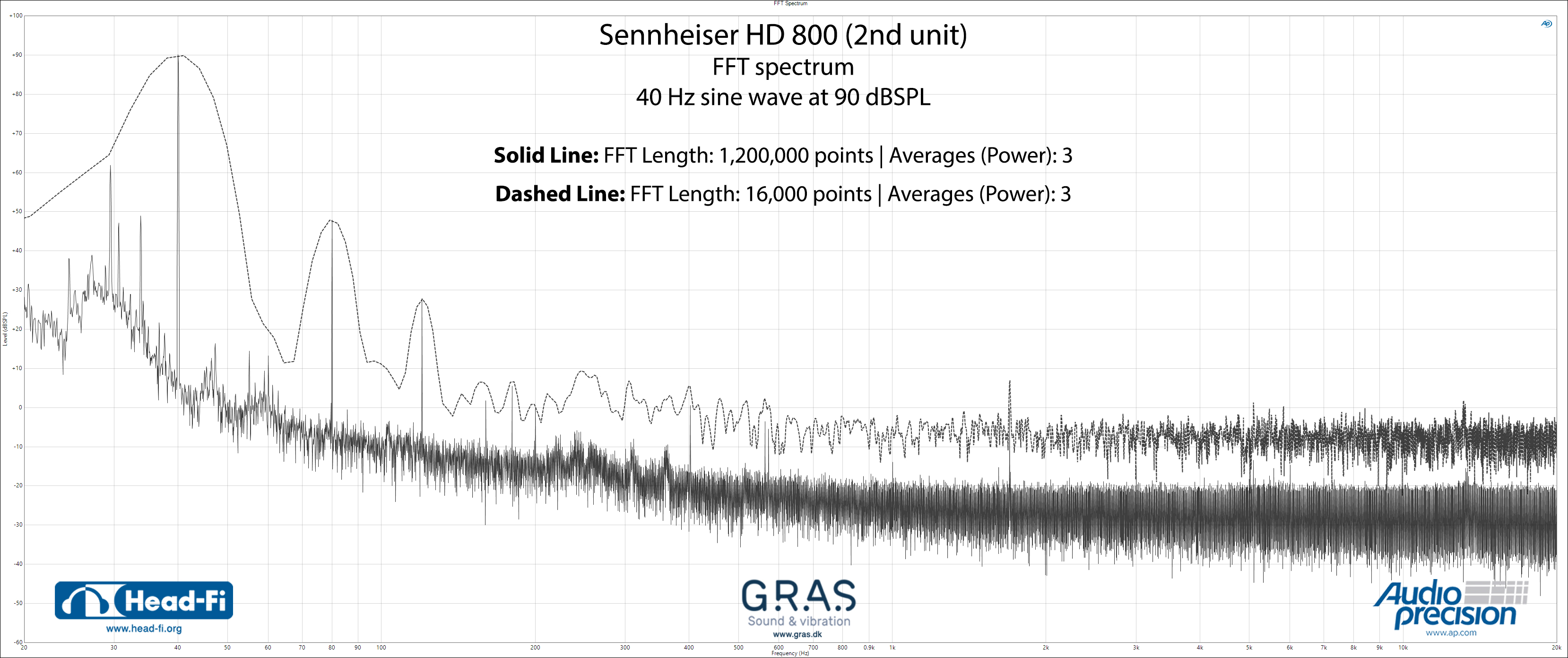daltonlanny
Headphoneus Supremus
- Joined
- Apr 6, 2007
- Posts
- 1,629
- Likes
- 209
Below is a copy of a post I made in one of the Sennheiser HD660S threads that is relevant to the Sennheiser HD800 and HD800S discussion. It is about the longstanding rumor that 2nd order harmonic overtones/distortion was added to the Sennheiser HD800S (versus the HD800):
I decided to examine this further here, with the one HD800 and the one HD800S we have. Here's what I did:
- First I did a quick FFT plot of the HD800 (16,000 points, no averages), playing a 40 Hz sine wave. I ended up with a plot that looked somewhat like this:

As you can see, that's not particularly detailed, so I took advantage of our audio analyzer's ability to do extremely detailed FFT's, opting for 1.2 million points, and doing three averages. Setting it to 1.2 million points provides a much more detailed plot, and the averages help remove random noise (better revealing the actual noise floor, too). Without having moved the HD800 from the above plot, here's the FFT re-run with 1.2 million points with three averages:

And here are the two overlaid:

NOTE: The examples above are actual measures of the Sennheiser HD800, but these were just quick preliminary measurements done without turning off the building's heating / ventilation systems. Even though we do employ a lab-grade acoustic and vibration isolation enclosure, the measurement gear is obviously very sensitive, so we still turn off the HVAC systems when we're doing audio measurements to lower the noise floor. As a result, the example measurements above may have a higher noise floor than the measurements that follow (which were done with the building's HVAC systems turned off).
- Again, the above measurements were just done as examples of two different FFT resolutions. Now let's get to the actual comparisons. Following are FFT spectrum measurements from the first seatings of the Sennheiser HD800 and Sennheiser HD800S, set to 1.2 million points and three averages, and playing a 40 Hz sine wave. I made the plot lines a bit thicker (and different colors) to try to make the two plots easier to distinguish from one another:

Here (below) is the same plot with cursor lines showing the difference at 80 Hz (80 Hz being the second harmonic of the 40 Hz sine wave fundamental tone, since we're examining the theory that the Sennheiser HD800S's richer sound is due to (as quoted above) deliberately added 2nd harmonic overtones/distortion):

The difference between the Sennheiser HD800 and Sennheiser HD800S at 80 Hz (H2) is only 2.783 dBSPL. Keep in mind that the center of this 2.783 dBSPL difference is occurring around 45 dBSPL lower than the fundamental tone. While the Sennheiser HD800S unit we have here does (to my ears) sound like other HD800S's I've heard (richer than the Sennheiser HD800), I do not believe this measured difference at 80 Hz suggests deliberately added 2nd harmonic overtones/distortion (to the HD800S versus the HD800).
- I decided to do a second seating of both headphones, also increasing the size of the headband for both headphones by one click on each side. Here (below) are the FFT spectrum plots from the second seating:

Again, this time (below) with cursor lines showing the difference between the two in this seating at 80 Hz (the second harmonic of the 40 Hz fundamental test tone):

The difference in this plot at 80 Hz is lower than the previous one, measuring only 1.673 dBSPL. As above, the center of this difference is about 45 dBSPL below the 40 Hz fundamental tone.
Again, keep in mind we only have one Sennheiser HD800 and one Sennheiser HD800S here at this time. I may measure more.
Based on discussions with Sennheiser and the above measurements of the Sennheiser HD800 and HD800S we have on hand, it does not appear there was any deliberate addition of 2nd order harmonic overtones/distortion to the HD800S as has been the common theory for the past couple of years.
If you have any other suggested tests you'd like to see performed on these two units here that you think might generate different results, let me know. That said, based on the THD measurements I posted in this thread earlier, and other measurements we've performed on these two headphones (also on the GRAS 45BB-12), I'm not surprised by the above results.
The measurements in this post were made using:
- GRAS 45CA Headphone Test Fixture with:
- GRAS RA0401 High Resolution Ear Simulators
- GRAS KB5010/KB5011 Anthropometric Pinnae for 45CA
- Audio Precision APx555 Audio Analyzer
- Audio Precision APx1701 Transducer Test Interface
- Herzan custom acoustic enclosure
Hi Jude. Very interesting indeed.
Not trying to disagree with your findings or anything, and definitely not defend Tyll Hertsens or anyone else, for that matter, but several other people, as well as other publications, (besides Innerfidelity), have measured significantly higher harmonic distortion in the bass below 80 hz on the HD800S compared to the HD800.
And this is with both headphones available to measure back to back.
Why would this be?
I personally find the HD800S to sound just a slight touch muddier and less distinct in the bass compared to my regular HD800, especially when listening to bass heavy music, plus my regular HD800 takes equalizing (boosting) the bass, better than the HD800S, which becomes even more muddy with low bass boost, compared to regular HD800...
Just sayin.
Last edited:




































































